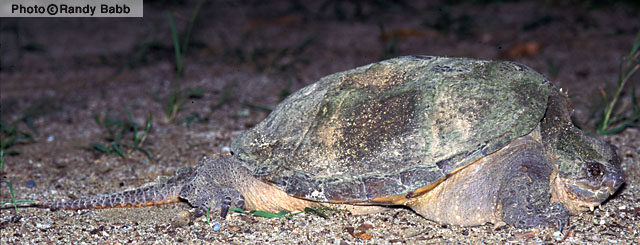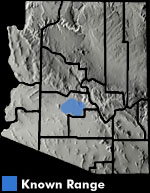Online Field Guide to The Reptiles and Amphibians of Arizona



| SNAPPING TURTLE Chelydra serpentina | |
|
DESCRIPTION: A large (shell up to 480 mm or 19″ in length), heavy-bodied, aquatic turtle with a long, spiked tail and a sharp, hooked jaw. The top part of the shell (carapace) is gray, black, olive, or dark brown and is often covered with mud and algae. The bottom part of the shell (plastron) is cream or off-white and is greatly reduced in size. The diminished plastron results in wide openings to accommodate the large chunky limbs. The feet are equipped with long, sharp claws. Young have three prominent ridges running the length of the carapace. These ridges become reduced as the animal ages. DISTRIBUTION: This turtle is native to the Canada and the eastern United States (east of the Rockies). It has been introduced to urban lakes and canals in the Phoenix metropolitan area. It might extend up and down the Salt River from Phoenix and into some of the surrounding desert reservoirs. HABITAT: Natural habitat includes the quiet, heavily vegetated waters of marshes, ponds, lakes, and slow moving rivers. In the Phoenix area it lives in shallow, man-made ponds, canals, urban lakes, and housing community lakes. BEHAVIOR: This highly aquatic turtle spends the majority of its time on the bottom of the lake, pond, or river often partially buried in mud or vegetation. It basks by floating in warm, sunlit water near the surface. It spends the cold winter months buried in the mud on the bed of the body of water. This turtle can strike with remarkable speed and does not hesitate to bite when captured. It is capable of inflicting serious injury with its sharp, powerful jaw and long, sharp claws. It is also capable of emitting a foul smelling musk when handled. DIET: An omnivore that feeds on crayfish, fish, insects, carrion, salamanders, reptiles, ducklings and other waterfowl, small mammals, and a variety of aquatic plants. REPRODUCTION: Most mating takes place in spring and summer. Most egg laying occurs in late spring or early summer. A clutch of 8 to 100 eggs is buried in a nest on the bank. By Thomas C. Brennan Brennan, T. C., & A. T. Holycross. 2006. A Field Guide to Amphibians and Reptiles in Arizona. Arizona Game and Fish Department. Phoenix, AZ Brennan, T. C., & A. T. Holycross. 2005. A Field Guide to Amphibians and Reptiles of Maricopa County. Arizona Game and Fish Department. Phoenix, AZ Stebbins. 1985. Western Reptiles and Amphibians. Houghton Mifflin. New York, NY Stebbins, R.C. 2003. A Field Guide to Western Reptiles and Amphibians, Third Edition. Houghton Mifflin Company, Boston, MA. |
|
Visit Partners in Amphibian and Reptile Conservation:


HOME
Copyright © 2023, Arizona Game and Fish Department. All rights reserved.
If you make use of the textual contents of this site in reports, publications, etc. please cite and credit the author(s) and photographer(s). All photos on this website are copyrighted. However, those found in the species account section may be used for any noncommercial scientific, educational, or conservation purposes provided that photographs are not altered and continue to bear the copyright symbol and name of the photographer. Please contact the photographer regarding commercial use of copyrighted photographs.










